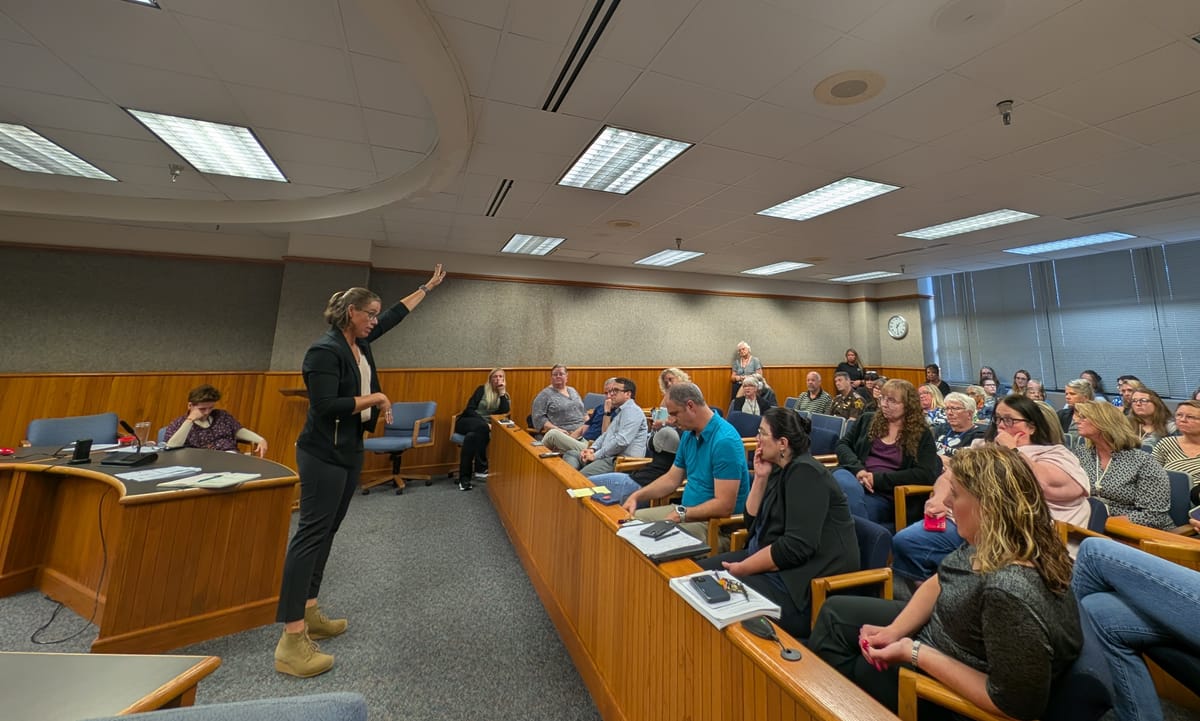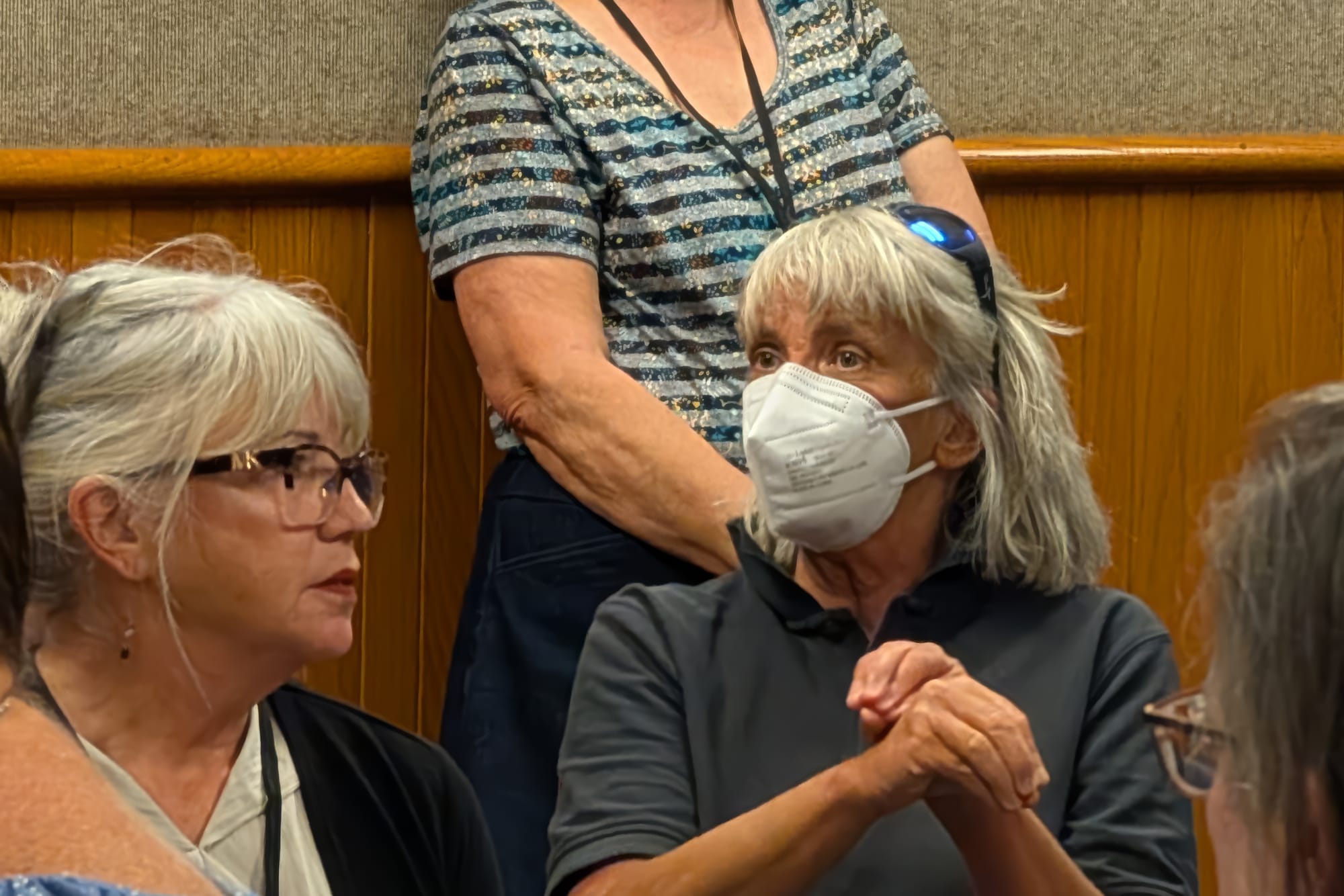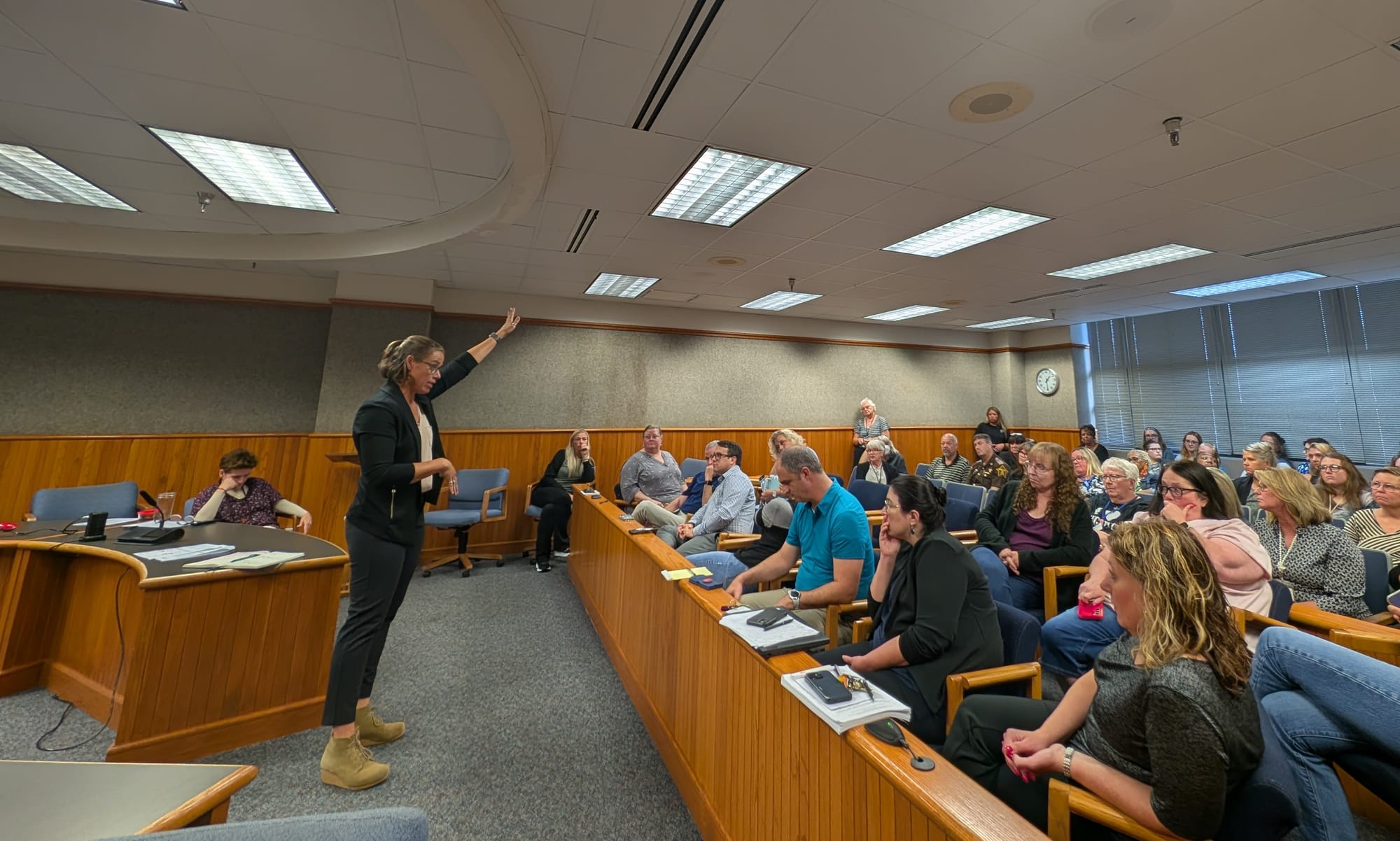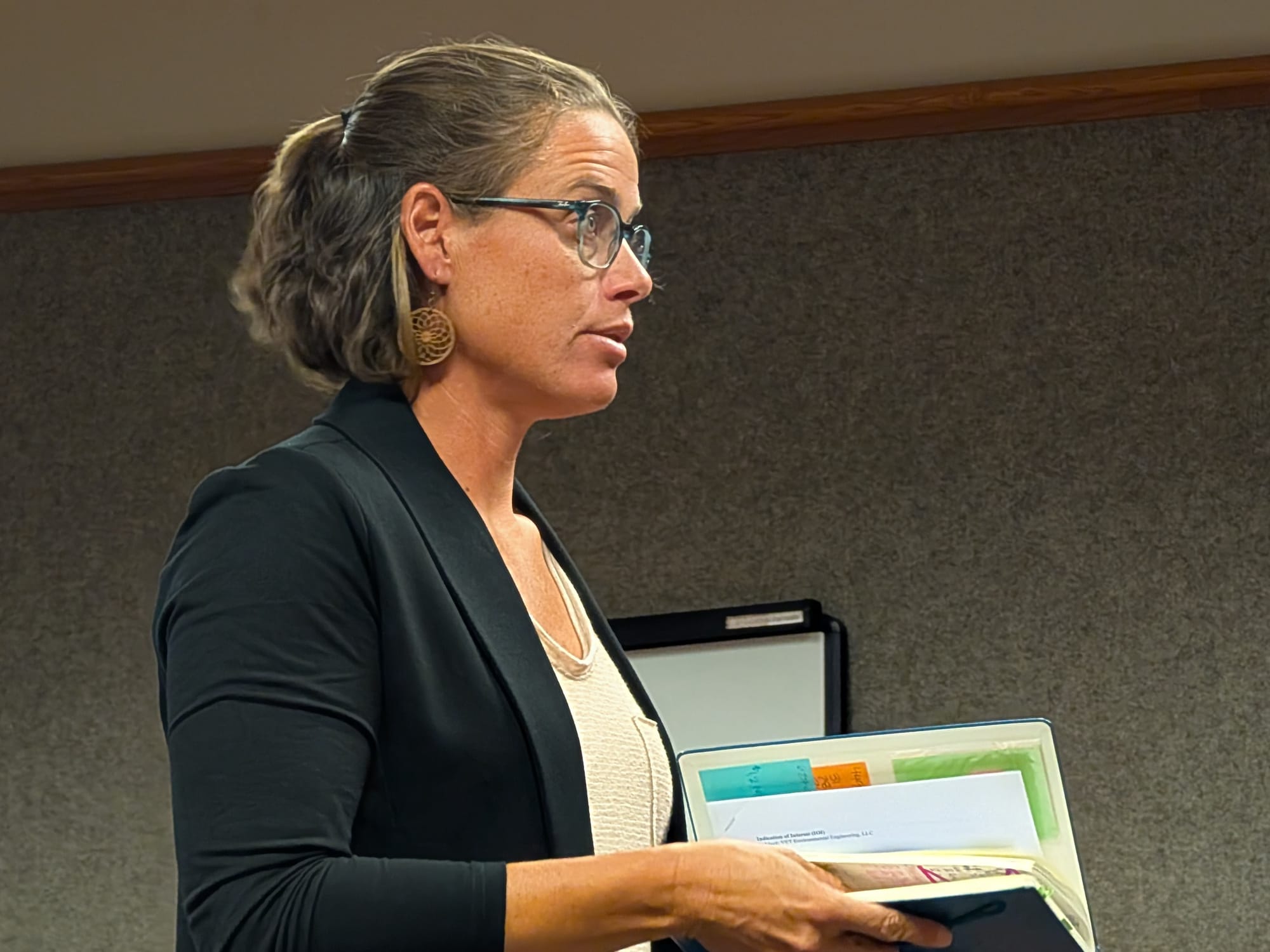Employee on mold at Monroe County justice building: “Band-Aids on the Titanic, telling us ... not to worry about the icebergs.”
On Thursday at least 70 county employees packed into Courtroom 313 to get a briefing from a contractor on the status of the mold investigation in their workplace. Some of them left the meeting dissatisfied that the county government had been doing everything in its power to ensure their safety.





Top left: Angie Purdie, administrator for the county commissioners and Julie Thomas (wearing mask), county commissioner. Top right: County councilor Jennifer Crossley. Bottom: Sara Hamidovic, with VET Environmental Engineering, addresses a capacity crowd in Courtroom 313 at the Monroe County justice building. (Dave Askins, Aug. 21, 2025)
On Thursday at noon, at least 70 county employees packed into Courtroom 313 on the north end of the Monroe County justice building to get a briefing from a contractor on the status of the mold investigation in their workplace.
Some of them left the meeting dissatisfied that the county government had actually been doing everything in its power to ensure their safety, and they aired grievances about possible mold contamination that go back years. An uneven sharing of the contractor’s reports by county commissioners—even to other electeds, like county councilors and judges—was a point of friction that emerged during Thursday’s briefing.
On Wednesday, after treating specific areas, replacing ceiling tiles, and scrubbing the air with HEPA filters, VET Environmental Engineering took a total of 76 air samples. The 76 samples covered all five floors, which includes the jail on the top two stories of the building. Those samples were driven to a laboratory in Indianapolis, which were to be analyzed starting Thursday on a three-hour turnaround time, according to Sara Hamidovic, founder of VET, who gave Thursday’s briefing.
[Added Aug. 22, 2025 at 8:10 a.m. A sign posted on the justice building this morning indicates that the prosecutor’s office is closed today (Friday, Aug. 22). Specifically, no initial hearings or traffic court will be held today, according to the signs. The B Square is working to confirm whether the closure is related to test results for mold.] [Added Aug. 22, 2025 at 8:59 a.m. The mold connection is confirmed.]
Hamidovic’s firm started its work in the building on Aug. 6.
“We are hoping to have first-, second-, and third -floor results today, and then fourth and fifth floor results first thing tomorrow,” Hamidovic told employees. As of the publication of this article, The B Square does not have confirmation that the hoped-for test results are back.
The fact that the test results were not yet back was a source of irritation for some of the employees, because it made them uncertain why they had been told to report to work that day.
On Thursday, Hamidovic expressed confidence that the work and testing that has been done so far, is effectively addressing the mold that has been identified. She put it in personal terms: “Based on what we know right now, I would, today, send my child to work in this building. No questions asked.” She added, “I do not think that there is an issue in this building that I would not put my kid in, period.”
Recent timeline of clean up work
The mold investigation became widely apparent to the public at large, when late morning on Tuesday (Aug. 19), some employees at the five-story building—which houses the sheriff’s office, clerk’s office, and courts, as well as the jail—were sent home until Thursday, shutting down services at the building. The announcement went out on the county’s emergency alert system. The cause for the premature end of the workday was the mold cleanup activity, which turned out to be more intrusive on their work areas than planned, according to Monroe County officials.
A complaint had been filed with IOSHA on Aug. 4, about “mold and mildew in the upper levels of the [justice] building that seeps down through the ceiling and drips onto the desks and workspaces.” Two days later, VET started its initial work. IOSHA sent Monroe County government a letter dated Aug. 12 advising about the hazards related to mold and describing options for dealing with mold, but stopped short issuing an IOSHA citation.
Hamidovic ticked through the work that VET had done, starting on Aug. 6 on the west offices on the third floor. Three surface samples were collected from ceiling tiles on the third floor, she said. Those samples were put on slides for review by a laboratory technician. Four indoor air samples were also taken. The initial work by VET is documented in a sampling report.
Of the four air samples taken on the third floor, three were within acceptable limits, but one showed elevated levels of Aspergillus, a common type of mold associated with increased humidity and water, Hamidovic said. The surface testing and the air sampling both indicated Aspergillus, which led to the work to remove and replace some of the ceiling tiles, Hamidovic said.
A week later, the team returned to the second floor, Hamidovic said. Two surface samples and five air samples were collected. Four of the five air samples were acceptable, but one was not. The air sample in one of the offices was elevated for Aspergillus and Stachybotrys.
In contrast to Aspergillus, which Hamidovic described as “very, very common,” Stachybotrys is not common. “That is a bad mold,” she said, noting it was found only in a small, localized spot on a ceiling tile “about yay big,” a size she indicated with her hand as a few inches across.
The ceiling tile with Stachybotrys was removed. “We did not find it in any other spaces. We have not identified it in any other space in the building,” Hamidovic reported.
Last Saturday (Aug. 16) VET technicians came back to the building and treated everything they could find that appeared to be active mold growth, according to Hamidovic. Then they fogged the areas with a product called RMR141, which is the brand name of a disinfectant whose active ingredient is dimethyl benzyl ammonium chloride. “We fogged from the prosecutor’s office all the way down to the conference room on the second floor, in all of those offices the hallway, and we did that twice,” Hamidovic said.
On Monday (Aug. 18), the team conducted follow-up air sampling in the area where Stachybotrys, the very bad mold, had been found. “One hundred percent of that harmful mold was killed. There were no detections of any spores on [the air sample], which is great, because that confirmed to us that the ceiling tile was the source, so we have eliminated that source,” Hamidovic said.
But Hamidovic said that levels of Aspergillus had increased—likely due to disturbance of ceiling tiles during removal. “We’ve been taking the ceiling tiles in and out. And so it’s normal that when you disturb a surface that has spores on it, more spores are in the air.”
On Wednesday this week (Aug. 20), comprehensive sampling was done in the building. “We did all five floors, 76 samples. Yesterday, those samples were driven to the laboratory in Indianapolis. This morning, they will be analyzed on a three hour turnaround time, which is the fastest turnaround time any laboratory can provide. We are hoping to have first, second, and third floor results today, and then fourth and fifth floor results first thing tomorrow,” Hamidovic told employees.
The plan for this weekend starting Friday (Aug. 22) includes more spot treatment, fogging, and confirmatory testing. “We are going to spot treat, we’re going to fog, and we’re going to remove anything else that seems problematic … It’s probably going to be a late Friday night, Saturday morning, and all day Sunday …” Hamidovic said.
Responding to a question from an employee, Hamidovic said she did not have a dollar amount for the work that VET had done to date, but said the company was keeping track. She confirmed to The B Square that it costs extra for the expedited turnaround time for the testing, which is done by an independent lab.
Hamidovic told the group that her firm’s instructions from the administrator for the county commissioners, Angie Purdie, had been to “make it right and make it right fast.” Hamidovic said, “That’s what we’re trying our very, very best to do.”
Drawing unintended skeptical laughs from the crowd of employees was a remark from Hamidovic related to advice to employees for the future: “So if you see a stain developing on a ceiling tile, it’s very, very, very important that you let someone know …”
The laughter came from the fact that some of them have long reported issues they believe are related to mold, without the kind of aggressive intervention that is now being seen.
Perspective: Prosecutor’s office
One of the employees who told Hamidovic on Thursday about previously reported conditions was April Wilson, who is one of county prosecutor Erika Oliphant’s deputies.
Wilson mentioned David Gardner, with ASI Facilities Services, which is Monroe County government’s outside contractor for building maintenance. Wilson said, “My first email to Dave Gardner regarding the water dripping in my ceiling this year was actually April 29 of 2025—so I did see something and say something. And alas, we’re here.”
Wilson continued, telling Hamidovic, “In addition to that, I don’t know if you’re aware that I actually reached out about water dripping in my ceiling tile in 2024.” Wilson continued, “Eventually it was removed. I will tell you the tile looked worse last year than the one that you just removed.”
Wilson added, “So it’s not an isolated, nor a new incident. And I do know a person used to be in my office, which actually is actually Erika Oliphant’s old office—she complained about concerns about mold back around 2016.”
Wilson put that long history in the context of Hamidovic’s presentation, which included the extra-humid weather in 2025: “I appreciate that this year was hot and maybe that was worse, but it’s nothing new. …”
Wilson wrapped up her remarks by saying, “I appreciate that we’re fogging. I appreciate that you’re removing tile. I think all of those are going to handle the mold that’s currently here.”
But Wilson told Hamovic that it appears there is a basic source problem of water leaks and an HVAC system that can’t contend with the humidity. Wilson said, “It feels a little like we’re putting Band-Aids on the Titanic and telling us all to go back to our rooms and not to worry about the icebergs.”
We’re all back in our posts working today,” Wilson said. She added, “I want to know that there is a five-year plan for every single soul in the justice building that is going to be a healthier and safer working environment than what we have been dealing with.” Wilson’s final comment drew applause from the crowd.
Five-year plan, commissioners, councilors
Attending the presentation was Monroe County commissioner Julie Thomas, who alluded to the current plan to build a new justice facility, including a new jail—a plan that is currently stalled due to a new state law that reduces revenues to local governments. A meeting for public presentation of schematic drawings that was supposed to happen on May 29, now looks like it will finally be held on Aug. 29 at 11:30 p.m.
Thomas said at Thursday’s briefing, “This building is sick, as you all know. This building needs to be replaced, as you all know. So the five-year plan is to get the heck out of here and get into a much better place.”
Thomas continued by saying it has been an ongoing issue because of the design of the building. Her characterization of staff’s “great job” responding to maintenance requests drew grumbles from employees at the meeting. “We have been putting Band-Aids on this building and putting things together with baling wire and chewing gum,” Thomas said.
Thomas alluded to a contract that had been approved by commissioners earlier that day at its regular meeting—a $26,000 agreement with VET Environmental for routine mold inspections at the county’s justice center, Johnson Hardware building (aka Election Central), the health building, and the courthouse.
“If something comes up again, you can be sure that we will address it as aggressively as we possibly can.” Thomas added, “I don’t want anyone to be ill from this. I don’t want anyone to be worried from this.” She said, “We are doing everything we physically can to help at this moment.”
A question arose in connection with the dissemination of VET’s reports to people who work in the building. For her part, Hamidovic said the contract is with the county commissioners, which means that she can provide the reports only to them—due to the confidentiality clause of the contract.
County councilor Jennifer Crossley indicated that she had not received all the reports that VET had produced. Angie Purdie, administrator for the commissioners, indicated she had sent county councilors the first one but not a second one.
The first one was sent by Purdie to councilors “because I thought you needed to know, because of the conversation about staying in this building,” Purdie said. But she continued, “I think that in the past, this has not been a council issue—you’re the fiscal body. You’ve provided the appropriation.” Purdie continued, saying about the second report: “I’ve ensured commissioners have had it. I’ve ensured that the elected officials who were specifically related to this incident have had it.”
“This is not normally your bailiwick, right?” Purdie said to Crossley, but added, “Happy to give it to you. … I’m hearing you now. Happy to send it to you.”
Crossley told Purdie that her frustration is not with Purdie. Crossley said, “My frustration is: If the commissioners particularly think that this is not our lane, where we need to stay out of it … then I disagree.” Crossley added, “Because it is our responsibility—because in some way, shape or form, everybody that’s in here will come to the council because of funding and whatnot, and we have that as a responsibility.”




Comments ()